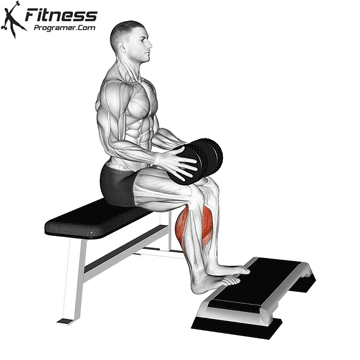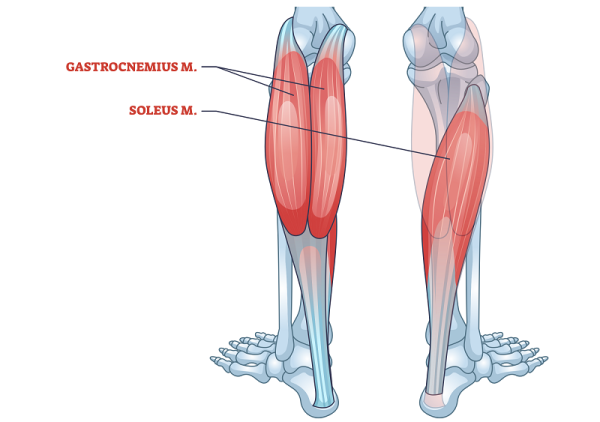Overview
The Weighted Seated Calf Raise involves sitting on a bench with a dumbbell or barbell placed across the thighs, feet elevated on a platform, and lifting the heels off the ground to perform ankle plantar flexion. This variation makes it ideal for developing lower leg size, strength, and endurance, and for improving ankle joint stability.
How to Perform the Weighted Seated Calf Raise

Setup: Sit upright on a bench with a dumbbell resting on your thighs just above the knees.
Foot Position: Place the balls of your feet on a raised platform with your heels hanging off the edge. Keep feet shoulder-width apart.
Starting Position: Hold the dumbbell securely with your hands. Keep your core tight and your torso upright.
Raise the Heels: Press through the balls of your feet to lift your heels as high as possible, squeezing your calves at the top.
Pause at the Top: Hold the peak contraction for 1–2 seconds for maximum activation.
Lower Slowly: Lower your heels until they’re just below the platform to feel a deep stretch in the calves.
Repeat: Perform the desired number of repetitions in a controlled, deliberate manner.
Tips for Proper Form
Keep knees bent at 90 degrees throughout the exercise to isolate the soleus.
Don’t bounce—use slow, controlled motion through the full range.
Ensure the dumbbell is stable on your thighs to prevent rolling or imbalance.
Focus on full contraction and a strong squeeze at the top of each rep.
Use a towel or pad under the weight if you feel discomfort on your thighs.
Common Mistakes
Using too much weight: Reduces control and increases injury risk.
Shortening the range of motion: Limits muscle activation—ensure a full lift and stretch.
Allowing the weight to shift or wobble: Distracts from the movement and affects form.
Moving too fast: Momentum reduces effectiveness and increases strain on joints.
Not holding the top position: Missing out on the contraction that maximizes growth.
Benefits of the Weighted Seated Calf Raise
Isolates the soleus muscle: The bent-knee position targets the deep calf muscle more effectively than standing exercises.
Improves ankle strength and stability: Strengthens plantar flexors that support balance, mobility, and injury prevention.
Enhances calf thickness: Soleus hypertrophy adds overall calf volume and shape.
Boosts performance in running and jumping: Strong calves transfer energy efficiently for explosive athletic movements.
Reduces injury risk: Strong soleus muscles help prevent Achilles tendonitis, shin splints, and ankle sprains.
Ideal for all levels: Can be scaled with weight and volume to suit beginners or advanced lifters.
No machine required: Can be performed at home or in any gym with minimal equipment.
How to Incorporate Into Your Routine
- For Beginners: Start with 2–3 sets of 12–15 reps using a light dumbbell to focus on form and range of motion.
- For Hypertrophy: Perform 3–4 sets of 15–20 reps with a moderate load, pausing at the top to maximize time under tension.
- For Strength: Use heavier weights for 4 sets of 8–10 reps, with longer rest periods (60–90 seconds) between sets.
- For Endurance and Stability: Use lighter weight with high-rep sets (20–30 reps) to train muscle fatigue resistance and support ankle health.
- For Athletic Training: Combine with standing calf raises to fully develop both gastrocnemius and soleus muscles for speed and jumping performance.
Weighted Seated Calf Raise: Muscles Worked

Frequently Asked Questions
How is this different from the standing calf raise?
Standing versions target the gastrocnemius more, while seated calf raises emphasize the soleus due to the bent-knee angle.
What weight should I start with?
Start with a light-to-moderate dumbbell and focus on control and range before progressing in weight.
Can I use a barbell instead of a dumbbell?
Yes, as long as you can balance it safely across both legs. A bar pad is recommended for comfort.
How often should I train calves?
2–3 times per week is ideal for most people. Calves recover quickly and can handle frequent training.
Can I do this exercise without a platform?
A platform allows for full range of motion. Without it, the stretch and effectiveness are reduced.
